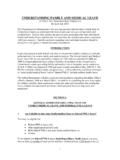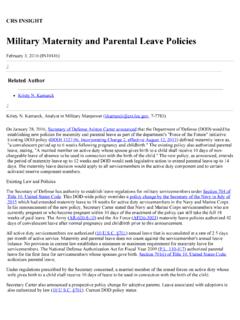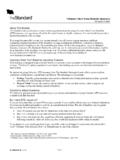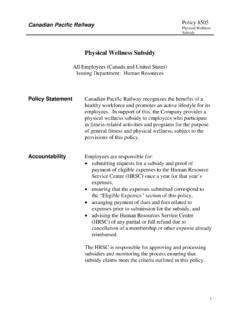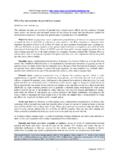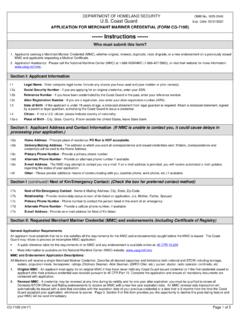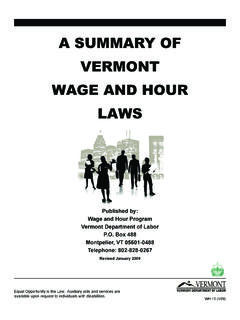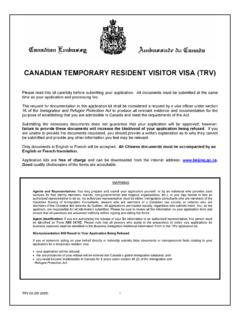Transcription of Maternity leave Parental and home care leave …
1 OECD Family Database OECD - Social Policy Division - Directorate of Employment, Labour and Social Affairs 1 Updated: 16-03-2017 Trends in Parental leave policies since 1970 Definitions and methodology This indicator provides information on trends in Parental leave entitlements from 1970 to 2015. The figures are based on a dataset developed using information on changes in the legislation regarding leave entitlements across OECD countries. The dataset contains variables on: - Maternity leave , that is, employment-protected leaves for mothers to be used around the time of childbirth. - Parental and home care leave , or those leaves that often follow Maternity leave and that allow one or both parents to remain home to care for young children, in some cases until the child reaches two or three years of age. - Father-specific leaves, that is, leaves reserved for the exclusive use of the father.
2 This includes paternity leave , individual entitlements to Parental leave and any weeks of sharable Parental leave that are reserved for use by the father only, plus any weeks of sharable leave that are effectively reserved because they must be used by the father in order for the family to qualify for bonus weeks of leave . Details of the variables contained in the dataset, including definitions, assumptions and coding rules, are given in the codebook section at the end of this document. Details on specific legislation and the various sources used to produce the dataset are provided in the annex to the indicator. Key findings The length and availability of paid leave has increased considerably across OECD countries in recent decades. In almost all OECD countries, the current length of paid leave available to mothers is longer than it was in 1970 and, to a slightly lesser extent, 1990 (Chart ).
3 In 1970, on average across OECD countries, mothers had access to just 17 weeks of paid leave . By 1990 this had increased to about 40 weeks, and by 2016 to just over one year ( ). The largest increases in paid leave have been in Finland and the Slovak Republic where in both cases mothers can now receive over three years of paid leave , compared to 9 weeks and 26 weeks in 1970, respectively but increases have also been considerable in a number of other countries. Korea, for example, provided mothers with just weeks of paid leave in 1990. As of 2016, it offers 15 months. Similarly, Canada currently offers mothers 52 weeks of paid leave , compared to 17 weeks in 1990 and 0 weeks in 1970. Decreases in the availability of paid leave are rare. Only four OECD countries (the Czech Republic, Germany, Hungary, and Sweden) currently offer mothers a shorter total period of paid leave than they did in either 1970 or 1990.
4 In Sweden this can be explained by the introduction of a father-quota in 1995. In the Czech Republic and in Germany, it is due to the introduction of payment scheme options, which allow parents to receive a higher payment rates if they choose to take leave for a shorter period of time. Other relevant indicators: Public spending on family benefits ( ); Key characteristics of Parental leave systems ( ); Use of childbirth-related leave by mothers and fathers ( ); Additional leave entitlements of working parents ( ); Public spending on childcare and early education ( ) and; Enrolment in day-care and pre-schools ( ). OECD Family Database OECD - Social Policy Division - Directorate of Employment, Labour and Social Affairs 2 Updated: 16-03-2017 Chart Length of paid Maternity , Parental and home care leave available to mothersa, 1970, 1990, and 2016 In weeks a) Information refers to weeks of paid Maternity leave and any weeks of paid Parental leave and paid home care leave (sometimes under a different name, for example, childcare leave or child raising leave , or the Compl ment de Libre Choix d Activit in France) that are available to mothers.
5 Data reflect entitlements at the national or federal level only, and do not reflect regional variations or additional/alternative entitlements provided by states/provinces or local governments in some countries ( Qu bec in Canada, or California in the United States). The length of leave available to mothers tends to be much longer in countries that introduced leaves earlier. Chart , for instance, shows the length of employment-protected Parental and home care leave available to mothers in 2016 with countries sorted according to the year in which they first introduced employment-protected Parental leave . With the exception of Italy, all those countries that introduced Parental leave before 1980 offer mothers at least one year of employment-protected leave . Indeed, six of these early movers (the Czech Republic, Finland, France, Hungary, Poland and the Slovak Republic) provide mothers with Parental and home care leaves that last two years or longer.
6 Those countries that first introduced Parental leaves after 1980 and particularly after 1990 tend to provide shorter leaves. The main exceptions here are Germany and Portugal, both of which first offered employment-protected Parental leave in the mid-1980s, and both of which currently offer mothers an entitlement to employment-protected leave for around or above two-and-a-half years. Chart Length of employment-protected Parental and home care leave available to mothersa by year of introduction, 2016 In weeks 020406080100120140160180 Weeks 201619901970020406080100120140160180 ItalyAustriaCzech RepublicSlovak RepublicPolandHungarySpain (b)SwedenFranceNorwayFinlandIcelandTurke yPortugalGreeceGermanyKoreaNew ZealandDenmarkCanadaNetherlandsJapanUnit ed StatesAustraliaIrelandBelgiumLuxembourgU nited KingdomMexicoSwitzerland1950196119641964 1968196919701974197719771980198119831984 1984198619871987198919911991199219931994 1998199819991999--Weeks OECD Family Database OECD - Social Policy Division - Directorate of Employment, Labour and Social Affairs 3 Updated.
7 16-03-2017 a) Information refers to Parental leave and subsequent periods of home care leave (sometimes under a different name, for example, childcare leave or child raising leave , or the Compl ment de Libre Choix d Activit in France). Data reflect entitlements at the national or federal level only, and do not reflect regional variations or additional/alternative entitlements provided by states/provinces or local governments in some countries ( Qu bec in Canada, or California in the United States). b) In Spain, Parental leave carries full job protection only for the first year. For the last two years of the leave only a return to a similar job or job of the same category is guaranteed. Paid father-specific leaves are a more recent development than paid leaves for mothers (Chart ). To all intents and purposes, paid father-specific leave did not exist in OECD countries in 1970, with only three countries (Spain, Luxembourg and Belgium) reserving fathers any kind of paid entitlement for father (for one day, two days and three days, respectively).
8 Little had changed by 1990, when the OECD average length of paid father-specific leave stood at just one day. In fact, only two countries (Denmark and Sweden) introduced paid father-specific leaves over the intervening twenty years. Since 1990, however, a majority of OECD countries have introduced at least some kind of paid father-specific entitlement. Between 1990 and 2000, six countries (Austria, Finland, Greece, Iceland, Norway, and Portugal) introduced paid leaves for fathers, while four others (Belgium, Denmark, Luxembourg and Sweden) expanded existing entitlements. Since 2000, a further eleven OECD countries introduced some kind of paid father-specific leave , bringing the OECD average to just over 9 weeks. The most striking reforms have been in Korea and Japan, where since 2008 and 2010 respectively fathers have held an individual entitlement to one year of paid Parental leave .
9 Other notable developments include the reform of the Portuguese Parental leave system in 2009 which saw fathers reserved or effectively reserved over 20 weeks of paid leave and the reservation of (at least) six months1 of paid Parental leave for fathers in France in 2014. Both Austria and Denmark have reduced or effectively reduced the length of leave reserved for fathers since 2000. In the former this can be explained by the introduction in 2008 of payment options that allow parents to receive higher payment rates if they take paid leave over a shorter period of time. In the latter, it is due to the abolishment of the father quota in 2002. Chart Length of paid paternity leave and paid Parental and home care leave reserved for fathersa, 1970, 1990, 2000 and 2016 In weeks 1 In France, the length of paid Parental leave and the leave of father-specific Parental leave vary according to the number of children.
10 The entitlements shown are for parents with only one child. 051015202530354045505560 Weeks 2016200019901970 OECD Family Database OECD - Social Policy Division - Directorate of Employment, Labour and Social Affairs 4 Updated: 16-03-2017 a) Information refers to entitlements to paid paternity leave , 'father quotas' or periods of paid Parental or home care leave that can be used only by the father and cannot be transferred to the mother, and any weeks of sharable paid leave that must be taken by the father in order for the family to qualify for 'bonus' weeks of Parental leave . Data reflect entitlements at the national or federal level only, and do not reflect regional variations or additional/alternative entitlements provided by states/provinces or local governments in some countries ( Qu bec in Canada, or California in the United States).










